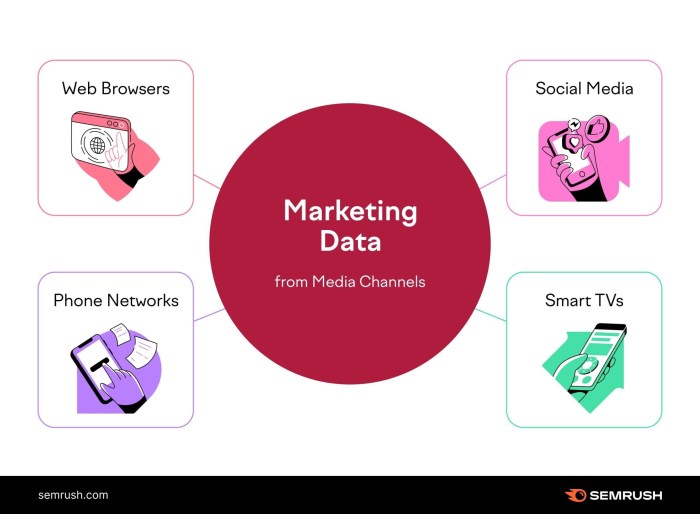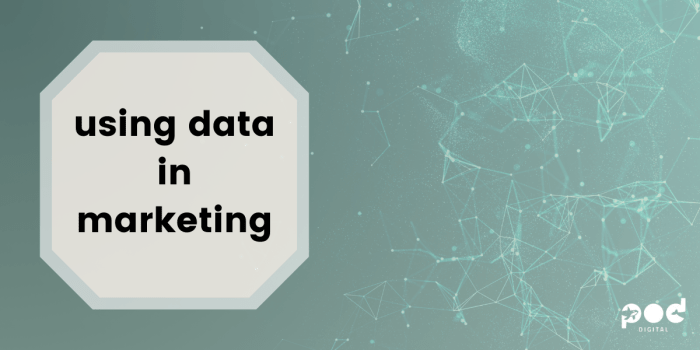Using Data for Marketing, let’s dive into how businesses can harness the power of data to drive successful marketing strategies and boost ROI. From targeted campaigns to personalized marketing, data is the key to unlocking growth and engagement in today’s competitive landscape.
Importance of Using Data for Marketing

Data is the lifeblood of successful marketing strategies in today’s digital age. By analyzing and leveraging data effectively, businesses can gain valuable insights into consumer behavior, preferences, and trends. This allows them to tailor their marketing campaigns to target the right audience with the right message at the right time, ultimately driving better results and return on investment (ROI).
Data-Driven Decisions for Better ROI
Making data-driven decisions is essential for maximizing ROI in marketing. By utilizing data analytics tools and techniques, companies can optimize their marketing efforts, allocate resources effectively, and measure the performance of their campaigns accurately. This leads to a more efficient use of marketing budgets and resources, ensuring that every dollar spent generates measurable results.
- By analyzing customer data, companies can personalize their marketing messages and offers, increasing customer engagement and loyalty.
- Tracking key performance indicators (KPIs) enables businesses to identify areas for improvement and adjust their strategies in real-time for better outcomes.
- Data-driven marketing allows for precise targeting, reaching the right audience with the right content, leading to higher conversion rates and sales.
Examples of Companies Excelling with Data-Driven Marketing
Amazon
Amazon is a prime example of a company that excels at leveraging data for marketing. Through sophisticated algorithms and data analysis, Amazon personalizes product recommendations, email marketing campaigns, and website content based on individual customer preferences and behaviors. This highly targeted approach has contributed to Amazon’s success as a global e-commerce giant.
Netflix
Netflix is another standout example of a company using data to drive its marketing strategies. By analyzing viewer data, Netflix can recommend personalized movie and TV show suggestions to its users, increasing user engagement and retention. The platform’s data-driven content strategy has helped Netflix become a dominant player in the streaming industry.
Starbucks
Starbucks utilizes data from its loyalty program and mobile app to deliver personalized offers and recommendations to customers. This targeted approach not only enhances the customer experience but also drives repeat business and loyalty. Starbucks’ data-driven marketing efforts have been instrumental in maintaining its position as a leading coffee retailer globally.
Types of Data Used in Marketing
Data plays a crucial role in modern marketing strategies, providing valuable insights into customer behavior and preferences. Let’s explore the different types of data commonly used in marketing campaigns.
Demographic Data
Demographic data refers to information about a population based on characteristics such as age, gender, income, education, and location. This type of data is essential for targeted marketing as it helps businesses tailor their messages to specific groups. By understanding the demographics of their target audience, marketers can create personalized campaigns that resonate with customers on a deeper level.
Behavioral Data
Behavioral data tracks how customers interact with a brand online, including their browsing habits, purchase history, and engagement with marketing content. This data provides valuable insights into customer preferences, allowing businesses to optimize their marketing strategies and deliver more relevant and personalized experiences. By analyzing behavioral data, marketers can understand what drives customer decisions and tailor their campaigns to meet their needs effectively.
Utilizing Data Analytics Tools: Using Data For Marketing

When it comes to leveraging data for marketing purposes, utilizing data analytics tools is essential for extracting valuable insights and making informed decisions. These tools help marketers analyze and interpret data to optimize their campaigns, target the right audience, and ultimately drive better results.
Popular Data Analytics Tools, Using Data for Marketing
Here are some of the popular data analytics tools used by marketers:
- Google Analytics
- Adobe Analytics
- IBM Watson Analytics
- Tableau
Comparison of Analytics Tools
Let’s compare and contrast the features of two popular analytics tools: Google Analytics and Adobe Analytics.
| Analytics Tool | Features |
|---|---|
| Google Analytics | Free to use, user-friendly interface, provides detailed website traffic data |
| Adobe Analytics | Advanced analytics capabilities, customizable dashboards, real-time data tracking |
Using Google Analytics for Marketing
Here is a step-by-step guide on how to use Google Analytics for marketing purposes:
- Create a Google Analytics account and set up tracking on your website.
- Define your marketing goals and set up conversion tracking to measure success.
- Analyze traffic sources, user behavior, and demographics to understand your audience.
- Use custom reports and dashboards to monitor key metrics and optimize your campaigns.
Personalization through Data Analysis
Personalization through data analysis is a powerful tool that allows marketers to tailor their campaigns to individual customers based on their preferences, behaviors, and demographics.
Benefits of Personalized Marketing Campaigns
- Increased customer engagement and loyalty
- Higher conversion rates and sales
- Improved customer satisfaction and brand perception
Successful Examples of Personalized Marketing Campaigns
One successful example of a personalized marketing campaign driven by data analysis is Amazon’s recommendation engine. By analyzing customer browsing and purchase history, Amazon is able to suggest products that are highly relevant to individual users, increasing the likelihood of a purchase.
Another example is Spotify’s personalized playlists, which are curated based on users’ listening habits and preferences. This personalization not only enhances the user experience but also encourages longer engagement with the platform.
Ethical Considerations of Personalization
- Transparency: Companies should be transparent about how customer data is used for personalization and provide opt-out options for those who do not wish to participate.
- Data Security: It is crucial to secure customer data and comply with data protection regulations to prevent misuse or unauthorized access.
- Respect for Privacy: Marketers should respect customers’ privacy and only use data for personalization purposes with their consent.












